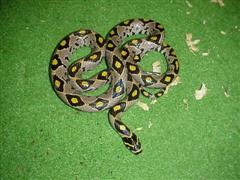Rat Snake - Mandarin
Mandarin Ratsnake Scientific Name: Elaphe mandarina
Sun, 24th November, 2024 - 8:20 am GMT
Sponsor Ads:

Alternative Name
Mandarin Ratsnake Scientific Name: Elaphe mandarinaBasic Info
These are medium sized ratsnakes that at maturity will reach anywhere from 3.5 to 6.5 feet in length. It is reported that males tend to be larger than females. The main color of the Mandarin Ratsnake is light gray. It has beautiful yellow and black markings on its body that make it incredibly stunning to behold. The head of this ratsnake is also quite beautiful with black and yellow lines that appear to form arrowheads and rings near the nose. Young Mandarin ratsnakes are very similar in appearance to adults, the main difference is the increase in intensity and contrasts between colors as the snake ages. The Mandarin Ratsnake is described as relatively non-aggressive. They rarely bite, and while younger snakes are described a bit high-strung, older Mandarin Ratsnakes apparently are a lot calmer.
Health
During the daytime the Mandarin Rat Snake should be kept at temperatures between 75 and 85 degrees Fahrenheit. In the evenings drop the temperatures to somewhere between 70 and 80 degrees Fahrenheit. This species also requires a moist hide spot with moist sphagnum moss. They should also have a dry hiding spot. Feed appropriate sized mice and when they get bigger provide pinkey and fuzzy rats. Do not handle for 24 hours after feeding. Breeding Captive bred specimens are increasing. Babies seem to do quite well on pinky mice.Habitat
They are usually found burrowed beneath moss and leaf litter in the forest and mountain regions of Southeastern Asia.Behavior
At one time the beautiful Mandarin Ratsnake was incredibly rare in captivity. Today this stunning snake is becoming more common among hobbyists. Native to Southeastern Asia, the Mandarin Ratsnake is truly one of the most beautiful species of Ratsnake in the world. Because Mandarin Ratsnakes can be difficult to keep and are relatively rare in captivity they can be rather expensive. Wild-caught Mandarin Ratsnakes are notoriously difficult to maintain in captivity. The Mandarin Ratsnake is very susceptible to disease when it is stressed. This combined with the fact that they are easy to stress, particularly after capture, contributes greatly to their high mortality rate when these snakes are imported from the wild. The average imported specimen usually only lives a couple of months. Luckily, captive breeding programs are increasing, so finding captively bred specimens is getting easier. It is strongly recommended that anyone interested in these snakes try to find a captively bred specimen. Specimens bred in captivity are said to be hardy and relatively easy to take care of. In the wild these snakes are largely nocturnal, meaning they are mostly active at night. They are usually found burrowed beneath moss and leaf litter in the forest and mountain regions of Southeastern Asia.Origin
Southeast AsiaHistory
The Mandarin Ratsnake originates in the forested areas and mountain regions of Southeastern Asia. It is most commonly seen in Vietnam, Southern China, and Northern Burma.Common Foods
N/ASponsor Ads:
Etorre's Observation: The other line moves faster.
Rat Snake - Mandarin
Coded by: BGID® | ALL RIGHTS RESERVED Copyright © 2000-2024
Disclaimer | Privacy | Report Errors / Contact | Credits








 Homosexual behavior stems from the mind or genetics?
Homosexual behavior stems from the mind or genetics?  The Best Text Adventure You Will Ever Play! The official site:
The Best Text Adventure You Will Ever Play! The official site:  Why haven't we as a collective earth met with aliens yet?
Why haven't we as a collective earth met with aliens yet?  World EcoSystem - Biodiversity Changes - Who is on board and who isn
World EcoSystem - Biodiversity Changes - Who is on board and who isn  Mouthwash - Mouthrinse - Mouth Sores - Healing Infections - Gingivitis
Mouthwash - Mouthrinse - Mouth Sores - Healing Infections - Gingivitis  Treatment for Depression
Treatment for Depression  Ultra radical and violent Islamist group that even rivals Al Qaeda
Ultra radical and violent Islamist group that even rivals Al Qaeda  An idea to have teachers who want to carry guns to school undergo some level of police training will be left up to local school districts and police departments.
An idea to have teachers who want to carry guns to school undergo some level of police training will be left up to local school districts and police departments.